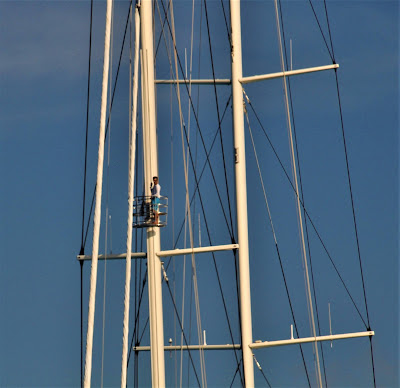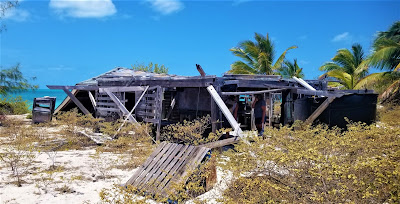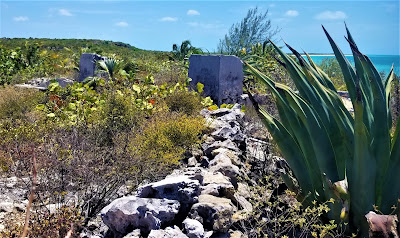This is one of eight mahi-mahi we hooked during two half days in the gulf stream 100+/- NM off the coast of northern Florida. One broke a rusty leader, three unhooked themselves, we threw two back and kept two. The freezer is full.
When we arrived at Water Cay, our first stop in the Jumentos/Raggeds, we were met by Ron and Mindy on their boat Follow Me. We were at the same marina in Guatemala and saw them a couple times along the US coast last year. The last time was in St Augustine in December.
Not only was it good to see them, but they also had some new starting batteries for us. The starboard starting battery went dead in Bimini. And ever since, whenever we wanted to start our starboard engine, Delana would have to go into that hull, turn on a switch that connected that engine to the port battery and then turn it back when the starboard engine started. We also had them bring a second battery, thinking if one went, the second was probably not far behind. Plus, it was a good deal.
With such easy access, replacing the batteries was a breeze.
Ron and Mindy also brought us a three part fix for our saildrives (transmissions). It's a long story, but Yanmar saildrives have a couple design flaws. One is that the gear lube is put under so much pressure that the seals that are supposed to keep the sea water out are forced partially fail. The other issue, is that the way the gears engage, the cone clutch needs to be re-lapped more often than it should. I did the gear lube pressure fix, but am waiting until we get back to VA before doing the other one. If I screw up, I'd rather be there, where someone can help me out, versus the Bahamas.
Shortly after anchoring on Water Cay this boat came by looking for ice. As you can see they had a lot of conch, as well as a bunch of big barracuda. We gave them as much ice as they wanted, which wasn't very much.
While they were tied up to Starship they cleaned three conch and gave them to us. They also cleaned the barracuda there, which attracted a couple big bull sharks.
The next day the four of us dinghied to the other end of the cay and climbed around these cool ancient sand dunes.
You can kind of see our boats anchored in the upper left hand corner.
In the mean time, these three guys set up a fish camp close to where we were anchored. First they catch some conch, clean them and then use them as bait in the traps to catch snapper. You can see the traps in the upper left corner of the photo. I brought them a couple diet Cokes and they gave us a cleaned snapper. That's my kind of fishing.
Even though the lobster season was closed they caught a couple, including this huge one.
The next day one of the bull sharks came back looking for more barracuda entrails. So I got in the water to take some photos. Note I didn't get too far from the boat.
This bull, as well as the other sharks we've run into while snorkeling, don't view people as food, so really don't get that close. That's my theory, though Delana isn't exactly on-board with it.
During day two this beautiful yacht boat came into the anchorage. If you look REALLY hard you can see a guy in the crows nest at the second spreader on the forward mast.
Here's a closer shot. The crows nest goes up and down like an elevator.
The name of the boat is Athos. At over 200' long, it's the largest privately owned two masted sailboat in the world. And like a lot of other huge yachts we've seen, if it wasn't for Covid it would probably be in the deeper Eastern Caribbean, rather than the shallow Bahamas.
Besides this big dinghy and other water toys, according to it's website, it also has a flying dinghy. That would really be fun.
It even looks cool at night.
When Athos' dinghy came to shore, Delana and Mindy went over to say hi. Actually they were hoping to finagle an invitation to come on-board. It was being chartered by an English couple from Manchester. Delana swears the guy was the former accountant of the Manchester United football team. His photo had been in the news for having just retired. By the way, despite the finagling, no invitation was offered.
This egret rested on a headsail sheet.
Our next stop was Flamingo Cay, where a wrecked sailboat greeted us. It was a lousy anchorage with a lot of swell. Swells are caused by waves that wrap around small islands and cause the boat, which is pointing into the wind and not the swell, to roll back and forth. That becomes annoying after awhile.
But there was a cave nearby to dinghy into
and on a hike we ran across a pool full of pink shrimp which is a food source for flamingos and are what gives them they're pink color.
Why isn't this night-heron pink then?
When we went out snorkeling Ron speared this grouper. After being speared it swam into a hole. It took Ron a good 20 minutes to get it out, all the time worrying that it would attract sharks.
The inevitable, laundry day.
Speaking of clothing. I use to see "distressed" jeans and caps for sale in various retail stores. As far as the caps go, I had worn ball caps all my life and had never had the bills fray like the ones for sale. However, now mine are all frayed just like, if not better, than the ones in stores. Plus, I also have a variety of "distressed" tee shirts. Any offers?
Happy hour on Follow Me. Its front is really set up well for entertaining.
Delana's re-upholstery and curtain projects both came out great.
Our next anchorage was Buena Vista Cay.
This is what's left of the only inhabited home on any the 130 islands, other than Ragged Island, after hurricane Irma hit in 2017. Before Irma the sole resident was in the process of building a restaurant/bar for cruisers. He was rescued three days after the hurricane, flown to Nassau and has never returned.
Both his grandparents and parents had lived on the island. These may have been the ruins of their homes.
Next was our favorite stop in the entire chain, Racoon Cay. It was very pretty, there wasn't any swell,
the water was great,
and for the Bahamas, the snorkeling was pretty good.
I don't think I had ever seen a live sand dollar before. The one on the right is alive. There were tons of both.
If Ron faced in the right spot, faced the right spot and stood on one leg he was able to get a little cell connection.
To save on concrete and add strength the interior of these old structures are often made up of shells and/or rock.
We had seen the remains of salt plantations before, but not one that wasn't flooded, or had so much clean pure salt produced by the evaporation process.
So Delana harvested a couple quarts,
dried and jarred it. It's good salt.
We shared the Racoon anchorage with this mega-yacht and it's crew of 12, which was was accompanied by a 80' sport fishing boat and it's crew of three. The owner would be shuttled over to the fishing boat every morning, go out fishing and be brought back each afternoon.
Then one day the same crew that walked the dogs twice a day brought over about 10 pounds of wahoo, which was really nice. With at least 17 people to feed they must have just gotten tired of fish. Again, that's my way of fishing.
They also gave Ron and Mindy fish, some of which we had on their boat that night. It was great.
There are quite a few paths on these islands, but virtually no maps. The paths are called flotsam paths because they are marked by anything from flip-flops to net floats, virtually any debris that washes up on shore. And of course, stacked rocks also work.
We found a bunch of sea biscuits someone had collected, but like us, probably already had as many as they wanted, so just left them.
We had seen goat tracks, as well as heard them on both Racoon and Buena Vista Cays, but so far hadn't seen any.
Then as we hiked to the salt plantation on Racoon we finally saw some.
Can you see why this was our favorite anchorage?
Next we met another couple we knew from the marina in Guatemala at Double Breasted Cay. And had another happy hour on Follow Me.
Just a funny shot of both Delana and Mindy hanging over the edge of their respective dinghies with masks on checking out reefs for snorkeling.
Part of what it's all about.
Our last stop in the Jumento/Ragged Islands was Duncan Town on Ragged Island. The nearest we could anchor was about three miles away, from where we followed this canal into town.
Duncan Town is the only settlement in the entire Jumento/Ragged chain. It is named after Duncan Taylor who was a British Loyalist.
He and his brother assisted in taking Nassau back from the Spanish in 1783. Their outnumbered Loyalist force outsmarted the Spanish by shuttling soldiers in small boats to a shore landing that was out of sight. The soldiers
would then lay down in the boats as they rowed back out to their small fleet
where they would stand up and be counted again by the Spanish as they rowed
back in. The Spanish added the numbers up and surrendered without a fight.
The brothers also built Ragged
Island’s salt ponds using slave labor, and by 1886 the town had more than 300 inhabitants. British emancipation freed the slaves in 1834,
but Ragged Island continued to trade salt for fruits, vegetables and other materials
from Cuba until 1960 when the Castro government came into power. At that
point coastal trade with Cuba became difficult and the salt trade all but died.
Coastal trade of another type, drug trafficking, came to Ragged Island in the
late 1970s and 80s. The relatively narrow gap between Ragged Island and Cuba is
patrolled by three different entities: the Cuban Coastal Defense Force, The
Royal Bahamas Defense Force and various entities of the U.S. government, including the Coast Guard. Cuban vessels wouldn’t chase drug-running boats
outside of Cuban waters and Bahamian/American craft wouldn’t chase them into Cuban waters. This allowed drug runners to leave Cuban waters
if Cuban vessels were spotted or enter Cuban waters if Bahamian or American
boats were in the area. Some of the drug boats would consequently end up in
Duncan Town’s harbor.
Like many of the Bahamian out islands there has been a steady loss of population to the more prosperous islands like New Providence, Grand Bahama, Abaco, Great Exuma and Eleuthera. The population of Ragged Island in the 2010 census was just 72. Then in 2017 Duncan town was devastated by two hurricanes including Hurricane Irma. Virtually every building was destroyed or significantly damaged and everyone was evacuated. There's probably only 20+/- people living there now. It looks like some rebuilding only began within the past six months or so. However, a new solar farm was completed last year. It is suppose to provide 90% of the islands energy needs.

Actually it's kind of hard to tell what buildings were damaged by the 2017 hurricanes versus the ones left in disrepair and abandoned. I bet since we've been in the Bahamas at least a third of the total buildings we've seen are abandoned. The same goes for cars.
Goats grazing among one of the rubble piles.
The hurricanes destroyed most of the trees also.
This construction overlook the canal we dinghied in on.
This is by far the largest of the three or four construction projects we saw underway.
We read about this restaurant with the plan of the roof, so had to check it out. It was a long walk. We met the woman whose husband started this project. However, he passed away so now her son is trying to finish it. Even if he does, I can't see there ever being enough customers to support it.
On the way back from the restaurant with the plane, we hitched a ride with someone who had just unloaded some barrels at the landfill. He took us down the airport's runway.
This is the waiting area at the airport. Seriously.
I'm not sure what they do with the pigeons, but there were a lot of them and they had a pretty nice place.
This was one of the two restaurants that were open, and the only one without really really loud music.
This is the town's functioning salt operation.
It used to be run by Morton, but now it's community owned and operated. Some residences harvest, package and sell salt under their own label.
Delana picking some tamarin pods.
Here's is Ragged Island's coat of arms. Good luck.
Back at the boat Delana removes the tamarin from the pods, does something to make them eatable and then uses them in some of the things we eat, I guess.
We left the Jumentos/Raggeds the next morning in the dark, so we could arrive at Long Cay before dark that night. There wasn't any wind so we mostly motored, but considering we were heading due east and the prevalent wind is from the east, we were good with no wind.
Next we'll be at Long Cay, Crooked Island and San Salvador. Then only one more blog to go.























































































Comments
Post a Comment